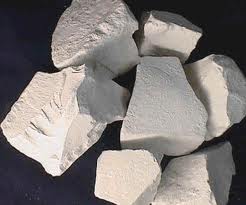
China-clay falls under the kaolinite group of clays. It has a usual composition of Al2O3 2SiO2 2H2O and is formed by the alteration of felspathic rocks. The important properties of china clay are that it has good plasticity, does not swell in water, can withstand high temperatures (1300 C and above) and is a non-conductor of electricity and heat. The white colour and the brightness are the other most desired properties by the users. It is used in large quantities in manufacture of porcelain, china-ware, crockery, ceramics, electrical insulators, as filler in paper and textile, as a filler and reinforcing agent in rubber goods, paints, cosmetics and pharmaceutical preparations.
There are two major products of China-clay. The chemical and physical properties of these products are described below:


